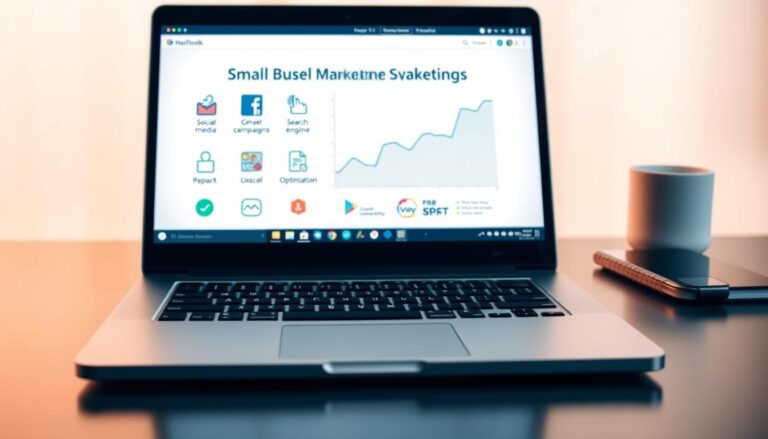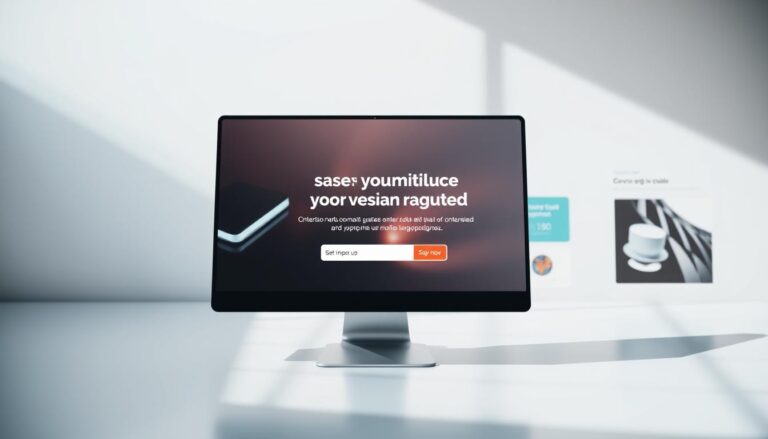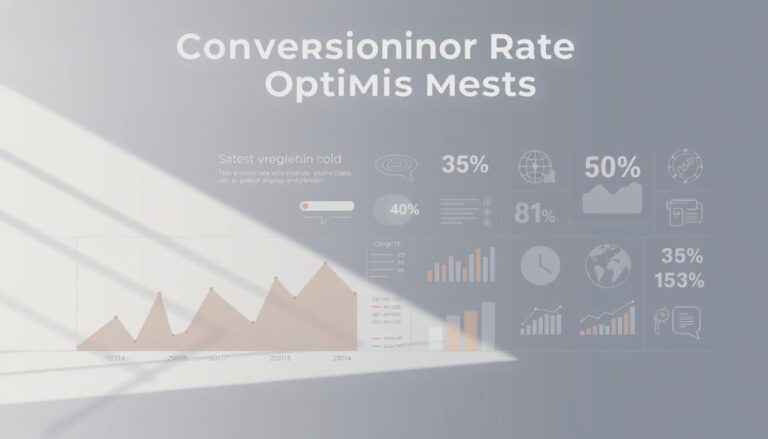The Future of Conversion Optimization: 10 Predictions for 2025 and Beyond
In 2025, speed, personalization, and trust will be key. Users want pages to load in under 2 seconds. Slow sites lose visitors, money, and trust. The future of conversion optimization is fast, data-driven, and focused on people.
Leaders use AI and adaptive UX to tailor experiences. McKinsey says companies that personalize well earn 40% more than others. Now, B2B buyers want easy self-service, clear prices, and mobile-friendly sites. This pushes teams toward MACH architectures for quick tests and learning.
Privacy is now a key feature. With third-party cookies disappearing, first-party and zero-party data are essential. Server-side tracking is also becoming standard. Smarter spending is also key, with top Google Ads accounts seeing 11.45%+ conversion rates.
Measuring success gets better. Teams focus on real metrics like micro-conversions and revenue per visitor. They use data to make informed decisions. This approach leads to sustainable growth and building trust.
Key Takeaways
- Speed is non-negotiable in 2025; sub-2-second loads drive the future of conversion optimization.
- AI-driven personalization and adaptive UX validate conversion predictions with real revenue impact.
- Privacy-first data and server-side tracking underpin reliable measurement and targeting.
- Predictive bidding with proven algorithms reallocates budget toward high-intent audiences.
- Business metrics—RPV, CLV, and time-to-first-value—replace vanity numbers in this industry forecast.
- MACH architectures enable rapid testing, supporting the optimization future and modern marketing trends.
Emerging UX/UI forces shaping conversions in 2025
Every click should be simple and safe. The future of conversion optimization focuses on fast loading, clear explanations, and user respect. Marketing trends show a future where design is data-driven, not just based on taste.

Speed, clarity, and accessibility as non‑negotiables
Speed builds trust. Aim for a sub‑2 second first view to show value quickly. Keep important content above the fold and copy short.
Accessibility boosts reach and revenue. Use high contrast colors, clear headings, and keyboard navigation. Support screen readers with detailed labels. These steps improve quality for all and reflect the future of conversion optimization.
Conversion-first minimalism and micro-interactions that reduce friction
Remove anything not helping a decision. Use 3–5 main menu items, plenty of white space, and easy-to-scan text. Show details only when needed.
Micro-interactions provide feedback. Use inline validation, clear error states, and progress bars in forms. This supports calm, focused flows in the optimization future.
Trust-building UI patterns: transparent pricing, security signals, and social proof
Show total cost upfront. Display shipping, taxes, and renewal terms before checkout. Use SSL, payment icons, and privacy policy to build trust.
Social proof should be real. Use verified reviews, recognizable logos, and recent activity. Clear support options reduce anxiety and strengthen credibility.
Performance optimization tactics: sub‑2s loads, lazy loading, WebP, and critical resource prioritization
Deliver the first screen fast with critical CSS and deferred scripts. Convert images to WebP and lazy-load below-the-fold assets. Use skeleton screens and progressive image loading to keep users engaged.
Compress fonts, limit third-party scripts, and cache smartly. These tactics align with the future of conversion optimization and reflect durable marketing trends.
Testing what matters: A/B tests, heatmaps, session recordings, and progressive rollouts
Run disciplined A/B tests, one variable at a time, and measure both conversion rate and revenue per visitor. Heatmaps reveal scroll depth and click bias, while session recordings expose confusion.
For larger UI changes, use multivariate tests and progressive rollouts to small segments before scaling. Track micro-conversions, completion rates, and time-to-first-value to inform conversion predictions and guide an evidence-based optimization future.
AI-driven personalization and predictive models transforming acquisition
You want growth that keeps growing, not just spikes. AI makes this possible by adjusting each visit in real time and guiding smarter media spend. As marketing trends change and the industry forecast points to data-light signals, the future of conversion optimization relies on models that learn quickly and protect privacy. Use these tools to make conversion predictions part of your daily decisions.

Adaptive UX that tailors journeys by behavior, device, and context
Adaptive UX replaces static flows with responsive paths. You can adjust product grids, CTAs, and copy based on device, location, and past behavior. Retailers fine-tune recommendations and pricing tiers, while B2B apps adapt onboarding by industry and company size.
This reduces early drop-offs and speeds the first “aha” moment. It also aligns with the industry forecast that favors fast, relevant experiences across channels.
Conversion prediction models for proactive bidding and audience prioritization
Think of predictive scores as a signal for ad engines and email systems. You can rank prospects before bidding and shift budget toward high-likelihood segments. Google Ads accounts in the top tier often use this approach to outpace average conversion rates.
Start simple: daily batch scoring and bid tiers. Then move to hourly or real-time once you see lift. This is where conversion predictions turn into working dollars.
First-party and zero-party data strategies in a privacy-first world
Collect first-party data such as page views, purchases, and session depth with consent. Add zero-party data like stated preferences through quizzes or profile forms. Use server-side pipelines, including Facebook Conversions API and Google Enhanced Conversions, to stabilize signals after iOS changes.
Unify attribution windows—such as 7-day click and 1-day view—so training data stays consistent. This discipline strengthens the future of conversion optimization under privacy constraints.
Algorithm choices: logistic regression, random forest, gradient boosting, and when to use each
- Logistic regression: Best for interpretability, audits, and low-volume datasets under 5,000 conversions.
- Random forest: Handles complex interactions with stable performance when features are noisy.
- Gradient boosting (XGBoost, LightGBM): Strong choice for performance marketing when speed and accuracy matter.
- Neural networks: Consider only with very large datasets and the right infrastructure.
Engineer features that capture time of day, recency, depth of engagement, and campaign source. These inputs power reliable conversion predictions that scale.
Business metrics over vanity: lift, ROAS improvement, and value-weighted conversions
Judge models by incremental value, not accuracy alone. Track lift, ROAS changes, and cost-per-conversion shifts. Weight conversions by expected revenue, margin, or customer lifetime value so spend flows to impact, not clicks.
Use holdouts to compare a model-optimized strategy against a baseline for at least two weeks, with enough traffic to reach confidence. This approach aligns with the marketing trends shaping today’s acquisition playbooks.
| Use Case | Recommended Algorithm | Key Features | Primary Metric | Deployment Pace |
|---|---|---|---|---|
| Low-volume lead gen | Logistic regression | Source, device, recency, pages per session | Lift on qualified leads | Daily batch |
| E-commerce prospecting | Gradient boosting (LightGBM) | Price sensitivity, product views, cart events, time of day | ROAS improvement | Hourly updates |
| Cross-sell/upsell | Random forest | Purchase history, category affinity, tenure | Value-weighted conversions | Daily batch |
| High-scale remarketing | Neural network | Sequence behaviors, long histories, creative signals | Cost-per-conversion reduction | Near real-time |
As you implement these steps, keep an eye on the future of conversion optimization across every channel. Align your roadmap with the latest marketing trends and the broader industry forecast, and let conversion predictions guide where you invest next.
Commerce infrastructure and ecosystem trends powering conversion growth
You need flexible systems to match shifting demand. The future of optimization is about modular tools and clean data flows. It’s also about ethical guardrails.
This forecast points to platforms that let you test fast and learn quickly. As marketing trends evolve, the future rewards teams that connect channels and respect customer choices.

Composable and headless architectures for agility and rapid experimentation
Composable commerce and headless setups let you swap components without a full rebuild. API-first patterns connect to ERP, CRM, and PIM for data sync. This way, you can test faster and scale what works.
Think MACH principles: microservices for speed, APIs for flexibility, cloud for scale, and headless for custom UX. This stack anchors the optimization future and aligns with your industry forecast.
Omnichannel consistency through unified data and integrated systems
Shoppers expect the same experience on every screen. A unified data layer enables seamless transitions between web, app, and service desks. Clear updates also cut support load and boost trust.
Integrated systems power loyalty logic, accurate promos, and real-time bundling. These steps reflect current marketing trends and the future of conversion optimization.
Sustainable, privacy-first practices building trust and long-term loyalty
With fewer third-party cookies, focus on consented first-party and zero-party data. Explain how data improves fit, speed, or savings, then honor preferences with simple controls.
Transparency on sourcing, carbon impact, and packaging signals care and rigor. Research from Publicis Sapient shows trust rises when brands share production details.
B2B experiences reaching B2C quality: self-service, transparent pricing, and mobile-first flows
B2B buyers now expect self-service portals, real-time inventory, and contract pricing. Mobile-first pages, fast reorders, and saved quotes reduce friction on complex carts. Clear approvals and budget flags cut delay.
These upgrades support the optimization future by compressing steps and clarifying value. They also align with marketing trends around speed, clarity, and proof.
Marketplaces and embedded commerce expanding discovery and reach
Marketplaces add reach while embedded commerce brings checkout into social, content, and productivity apps. AI improves search relevance and low-touch purchases, guiding buyers to the right SKU at the right time.
Use channel data to refine titles, images, and bundles, then loop wins back into owned storefronts. For engagement tactics, explore gamified promotions that boost repeat actions. Done well, these moves echo the future of conversion optimization while matching the broader industry forecast on buyer behavior.
future of conversion optimization
You’re entering a new era where UX, AI, and modular commerce grow together. Speed, clarity, and easy access are key. Sub-2-second loads are now the standard. Trust signals, micro-interactions, and feedback help users feel secure and reduce drop-off.
Marketing trends favor simple paths and quick answers. This shift is driven by the need for fast and clear user experiences.
A privacy-first approach leads in data handling. You use first-party and zero-party data, server-side tracking, and unified attribution windows. This approach turns conversion predictions into reliable guidance, not just guesses. For complex paths, a Markov approach can track many touchpoints. Yet, only about a third of teams are confident in attribution, as this primer on the future of conversion explains.
Acquisition is moving from reactive to proactive. Start with logistic regression to rank leads. Then, use gradient boosting for stronger lift without heavy overhead. Deep learning is for very large datasets. This staged approach supports ROAS gains, smarter bids, and cost control, aligning with the optimization future.
Commerce infrastructure is becoming composable and headless. You can test flows, payments, and content without freezing the whole stack. Omnichannel links ensure consistent messages and prices across different platforms. Sustainable and transparent practices protect trust while scaling, matching durable marketing trends.
B2B experiences now meet B2C standards. Self-service, mobile-first flows, and clear pricing help buyers move at their own pace. Data shows that webinars plus personalized emails can convert half of leads to opportunities. Paths without follow-up lag behind, guiding product-led tactics.
Measurement is evolving beyond single “last click” tracking. You track micro-conversions and time-to-first-value, then add revenue per visitor and CLV. Use chronological splits and holdouts to validate gains. As results stabilize, progressive rollouts limit risk and keep learning active across devices and channels.
| Path or Tactic | Observed Outcome | Practical Takeaway | Relevance to optimization future |
|---|---|---|---|
| Webinar → Personalized Email | ~50% convert to opportunities | Pair high-intent events with timely follow-up | Feeds conversion predictions and prioritizes outreach |
| Paid Ad → Whitepaper → Email Drip → Demo | ~5% convert to opportunities | Nurture with education before sales touch | Improves forecast quality and bid tiers |
| Paid Ad → Whitepaper → No Follow-up | ~2% convert to opportunities | Automate follow-ups to prevent value leaks | Guides budget reallocation across marketing trends |
| Multi-touch Journeys (Markov model) | Six touchpoints credited with 100+ conversions each | Invest in assistive steps, not only last click | Strengthens multi-touch conversion predictions |
| Attribution Confidence | ~1/3 feel highly confident | Adopt unified windows and holdout tests | Foundational for the future of conversion optimization |
For your roadmap, phase work by stage. MVPs focus on clarity, fast pages, and easy CTAs. Growth emphasizes experimentation, personalization, and progressive rollouts. Mature teams refine accessibility, scale models, and schedule retraining to tame drift—steps that align with the optimization future and evolving marketing trends.
Measurement frameworks and experimentation discipline
You win conversions by measuring the steps that predict them. Anchor your plan to clear goals and align with current marketing trends. Let data guide pace and scope. This sharpens your industry forecast and keeps your team focused.
Micro-conversions, time-to-first-value, bounce and completion rates that predict outcomes
Track signals that move early. Focus on micro-conversions like email sign-ups and add-to-cart actions. Also, watch bounce rate and time-to-first-value.
These inputs sharpen conversion predictions and expose friction early. Layer context with session duration and pages per session. Use qualitative tools like heatmaps and surveys to understand the “why” behind the numbers.
For a practical guide on goal setting and analysis, see this resource on CRO analytics.
Revenue per visitor and CLV to evaluate long-term impact
Balance speed with value. Revenue per visitor connects conversion rate to average order value. Customer lifetime value (CLV) shows how changes affect cohorts over months.
- RPV for near-term efficiency and offer strength
- CLV for retention, cross-sell, and sustainable growth
- Incremental ROAS and cost-per-conversion to validate lift
Time-based validation: chronological splits and leakage-safe model training
Train on the past, validate on the near future, and test on a later period. Use expanding-window time-series cross-validation to account for seasonality. Guard against data leakage by keeping features and labels aligned to their true timestamps.
- Chronological train/validate/test to mirror live traffic
- Expanding windows to capture trend shifts
- Model checks: precision, recall, and AUC-ROC 0.7+ before rollout
Holdout testing and unified attribution windows for cross-platform reliability
Run holdouts to separate model lift from noise. Split traffic 50/50 between baseline and optimized strategies. Run at least two weeks and confirm sample size with confidence intervals.
Define unified attribution windows—such as 7-day click/1-day view—to keep reporting consistent across ad platforms and analytics.
- Set a unified attribution lookback for clean comparison
- Validate with A/B and holdouts; then roll out progressively
- Instrument with heatmaps and recordings to explain lift
When the tests pass, phase changes with guarded rollouts. Document wins, losses, and edge cases. This refines your industry forecast, strengthens conversion predictions, and keeps you aligned with the future of conversion optimization.
Stage-specific roadmaps for MVP, growth, and mature products
Move faster with a roadmap that shows your product’s growth. It helps align teams, budget, and tech choices with future goals. Every release should aim for measurable results, based on your industry forecast and optimization future.
product lifecycle metrics help you know what to track as you grow. A focused roadmap prevents overbuilding. Marketing trends suggest fewer features, simpler journeys, and smarter data use, which apply across all stages.
MVP focus: clarity, streamlined CTAs, simplified navigation, and fast performance
Validate value quickly. Keep navigation simple with 3–5 items. Use one main CTA per page with clear buttons and text. Design for mobile first with short forms and easy-to-read labels.
- Speed: compress images, minimize JavaScript, and use a reliable CDN for fast loads.
- Reduce noise: avoid carousels, autoplay, and pop-ups that distract.
- Access: make tap targets large and fix errors easily.
Use stage-aware KPIs like task completion and LCP from the product development lifecycle. Then, improve based on real user data.
Growth-stage playbook: A/B testing, micro-interactions, and adaptive onboarding
Focus on experiments that reduce friction and increase intent. Test different signup flows and CTA placements. Add progress indicators and friendly loading states to keep users engaged.
- Personalize onboarding based on company size, industry, and activity level to lower early churn.
- Use server-side tracking, heatmaps, and session recordings to guide your tests.
- Watch retention, CAC, and NPS as you scale your wins.
Link experiments to the optimization future with predictive models. This aligns with marketing trends that favor lasting growth over quick gains.
Mature product priorities: accessibility, scalability, and advanced personalization
Scale with WCAG-compliant design, keyboard navigation, and clear headings. Maintain a consistent design system and performance budget. Use CDNs, progressive loading, and efficient database queries.
- Go beyond segments with recommendation engines and dynamic content linked to outcomes.
- Balance accuracy and speed with gradient boosting or ensembles; reserve deep nets for large datasets.
- Keep unified attribution windows and active holdout testing.
As your industry forecast changes, align CLV and revenue per visitor to guide investments in personalization and infrastructure.
Operationalizing change: data quality, model drift monitoring, and retraining cadences
Make optimization a system. Check data weekly for completeness and outliers. Monitor model drift using business metrics, not just AUC. Retrain monthly, or sooner after major changes.
- Governance: document experiments, automate reporting, and standardize KPIs across teams.
- Integrity: use chronological splits, leakage-safe training, and stable holdouts.
- Roadmap fit: in early stages, pair OKRs with a lightweight roadmap; in maturity, an OKR-only rhythm can work, as noted in guides to product roadmaps.
| Lifecycle Stage | Primary Goals | Key Metrics | Core Tactics | Data & Modeling |
|---|---|---|---|---|
| MVP | Prove value fast; remove friction | Task completion, Page load, CLS, LCP | 3–5 nav items, one CTA per page, image compression, CDN | Basic tracking, simple funnels, qualitative feedback |
| Growth | Scale adoption; reduce early churn | Retention, CAC, CLV, NPS, Feature adoption | A/B tests, micro-interactions, adaptive onboarding | Server-side events, heatmaps, session recordings, uplift models |
| Mature | Sustain profit; protect experience | LTV, Churn, Support volume and resolution time | WCAG compliance, design system, progressive loading | Ensembles/gradient boosting, unified attribution, holdouts |
Conclusion
The future is clear. We need to mix conversion-first UX with privacy-safe data and smart models. Use a flexible, all-channel system. Make sure pages load fast, be open about costs, and make things easy for everyone.
First-party and zero-party data, along with smart tracking, bring back important insights. This helps improve sales and makes predictions better across all channels.
Focus on areas where you can grow the most. Start with daily scores and simple prices, then get better over time. Marketplaces and built-in shopping can help you reach more people without spending too much.
Being green and open builds strong customer loyalty and keeps people coming back. These trends show that brands that deliver fast, listen to data, and keep improving will stay ahead.
Watch the right numbers. Look at small wins, how fast you get value, sales per visitor, and customer lifetime value. Use real tests and careful tracking to avoid mistakes.
Set goals that really matter to your business, not just to look good. This way, you’ll do better than others in the US.
Plan your steps carefully. For the first version, focus on being clear and quick. In growth, use tests, smart UX, and quick feedback. For more advanced stages, work on making things better for everyone, scaling, and personalizing more.
For more on what’s next in improving conversions, check out this brief on the next era of. Keep your strategy based on solid data, discipline, and focusing on what customers want.






